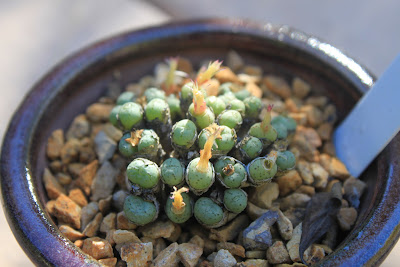Most of my plants are succulents, perfectly suited to my arid gardens. However, Mother Nature devised a diverse landscape for many reasons and with what my ability, experience, and environment will allow, I try to observe her principles. Besides, there are so many other plants I love! One prerequisite though...they must be able to thrive, not just survive, with little water. Over the years, I have been astonished at the drought tolerance of many plants I previously assumed were water thirsty. Many are indigenous to the semi-arid or subtropical regions of the world, but not all. Sometimes, it just comes down to soil and microclimates. Here are a few I recommend for the frost-free, semi-arid garden. Keep in mind they are mature plants and more capable of handling dry periods. I omitted the obviously well suited California Native plants, as that will be a future post!
 |
Gazania rigens
This low growing perennial is tough as nails. It is tolerant of many soil, light, and water situations. I've seen Gazanias grow in the hot desert sun as beautifully as a semi shaded cottage garden. The flowers, which occur in many colors, are large, bright, and gorgeous! My Gazanias wilt when not watered enough during hot months, but they easily spring back with the next drink. |
Echium candicans, "Pride of Madeira"
Beautiful, strappy, blue-gray leaves throughout the year with conical towers of purple flowers in spring. Although it will tolerate year round irrigation in sandy soils, I never water my plants. In summer, many of the leaves drop, exposing the dark, twisted branches/trunk.
Platycerium superbum
A drought tolerant fern? Technically no, but this one gets honorable mention because it can go a relatively long time in summer without water. Pictured is a 30 year old plant that has built up several layers of moisture retentive dead fronds and decaying material behind
the growing point. As you can see by the sparse growth on the ground under this fern, I don't water often!
 |
Adiantum pedatum "Maiden Hair Fern"
This is another fern that is surprisingly drought tolerant. It is growing in bright shade, in a raised planter filled with amended soil. I try to water this garden about every ten days in summer but it has gone without for much longer. A great choice for dry shade. |
Vitex agnus-castus "Chaste Tree"
This beautifully spicy scented shrub/small tree produces spikes of lavender colored flowers in spring. It is also known to have valuable medicinal properties. My husband thinks it's Marijuana! Vitex is winter dormant in my area, losing all of its leaves by late fall. It's growing in almost pure clay, and get's only a few soakings in summer.
 |
Grevillea lanigera 'Mt. Tamboritha'
Most grevilleas do well in my area but they seem to enjoy sweeter soil, which mine is not. This grevillea has grown superbly in my garden, among succulents, hanging over the edge of block planters which radiate a lot of heat in summer. I water here and there, but this plant has gone weeks without water. Hummingbirds love it! |
 |
Plumeria rubra
Plumeria, the quintessential Hawaiian plant. Tropical in look and culture, right? Gladly, they do very well here, tolerating low water and lots of sun and heat. They look like succulents, with thick, fleshy branches/trunks. Mine go quite a while without water. They are all in pots so I can move them during winter. They do not like to be cold and soggy. Plumeria are in landscapes all over San Diego.
|
 |
Crinum powelii(?)
A large bulb with fallen, strappy leaves and beautiful fragrant flowers in spring, growing in sandy loam in full sun. Another plant that I rarely water, although the lower leaves dry up during mid summer leaving the plant a little disheveled. It recovers quickly with the first rains in Autumn. The bulbs are poisonous so I don't have to worry about critters! |
 |
Coleonema pulchellum "Sweet Breath of Heaven"
This plant emits a sweet, herby scent that is, well, a "Sweet Breath of Heaven." I love this plant. I have five; two growing in heavy soil/full sun; two growing in semi-shade in garden soil; and the last growing in almost full shade (pictured), in sandy loam. I rarely water, even in the hottest part of summer, yet this plant stays wispy and delicate.
|
 |
Oxypetalum caeruleum "Tweedia"
One of the truest blue flowers you will see in nature. It is extremely tough, tolerating heat, full sun, even compacted soil. I water about once a month in summer. This member of the Milkweed family stays compact and is a good companion to full sun cacti/succulents. |
















































